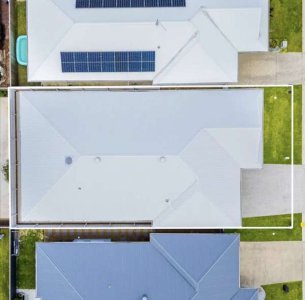Is this the future of Australian housing? See what others think about this massive change
By
Danielle F.
- Replies 60
Owning a home with a sprawling backyard has always been a part of the Australian dream.
However, Aussies have faced a harsh reality check that could change things drastically.
A photo depicting a newly built home has gone viral on social media but for all the wrong reasons.
Instead of an expansive outdoor space, the house has consumed the entire plot of land, leaving little to no space.
This image, shared by property firm Spachus, immediately became a symbol of the disturbing future of housing in Australia.
The photo sparked a wave of criticism and highlighted the irony of the housing crisis debate.
Australians have long cherished the idea of a spacious backyard, yet the new detached houses cropping up in the suburbs tell a different story.
The homes are virtually touching each other, with only tiny strips of grass at the rear.
Yet, this trend is not isolated to one area; real estate listings in Sydney, Melbourne, and southeast Queensland showcase similar homes, indicating a widespread shift in housing design.
However, the rise of apartment living is not to blame.
Dr Elek Pafka, a Senior Lecturer in urban planning and urban design at the University of Melbourne, pointed out that Australian houses have grown in size over the past few decades.
Australian homes now average 230 square metres, surpassing the average United States home.
This increase in house size, coupled with unchanged or reduced lot sizes, could leave homeowners with minimal green space and little room between properties.
The Death of the Australian Backyard, a book published by housing expert Tony Hall, documented the drastic changes in home design that began in the 1990s.
The shift towards houses within a few metres of the property boundaries has been rapid and dramatic, with an aerial photo backing up the claim.
These densely packed suburbs with detached housing are often found on the outskirts of major cities, where urban sprawl has been rampant for years.
The current housing development debate has been reignited by the urgent need to address a supply shortage and affordability crisis.
Prime Minister Anthony Albanese's plan to build 1.2 million new homes within five years leaned heavily on higher-density living, particularly through mid-rise apartment complexes.
On the other hand, the housing market has seen significant price increases since the pandemic.
National home prices at the time ballooned by 38.1 per cent, equivalent to an average price of $814,000.
Meanwhile, homes in capital cities jumped up to 33.6 per cent, with an average price of $900,000.
Renters also feel the pinch, with median weekly rents rising annually.
In response, authorities in Sydney and Melbourne have pushed for increased density near public transport hubs, with plans for hundreds of thousands of new, apartment-style dwellings.
These developments should accommodate growing populations in cities, all while maintaining liveability through the inclusion of parks, schools, and public spaces.
Other major centres like Brisbane and Adelaide have also turned to greater density to manage their expanding population.
However, with building commencements trending lower and dwelling approvals below the ten-year average, the construction industry has faced significant challenges, including a number of insolvencies.
This viral photo serves as a cautionary tale for Aussies, especially for seniors who are used to the idea of an expansive outdoor greenery at home.
The dream of a spacious backyard may be fading, but with informed choices and a push for better planning, there's hope that future generations could still enjoy the outdoor lifestyle that's been a part of the Australian way of life.

What are your thoughts on the recent changes in Australian homes? What do you think about the rise of high-density housing? Share your opinions about this matter in the comments below.
However, Aussies have faced a harsh reality check that could change things drastically.
A photo depicting a newly built home has gone viral on social media but for all the wrong reasons.
Instead of an expansive outdoor space, the house has consumed the entire plot of land, leaving little to no space.
This image, shared by property firm Spachus, immediately became a symbol of the disturbing future of housing in Australia.
The photo sparked a wave of criticism and highlighted the irony of the housing crisis debate.
Australians have long cherished the idea of a spacious backyard, yet the new detached houses cropping up in the suburbs tell a different story.
The homes are virtually touching each other, with only tiny strips of grass at the rear.
Yet, this trend is not isolated to one area; real estate listings in Sydney, Melbourne, and southeast Queensland showcase similar homes, indicating a widespread shift in housing design.
Experts believed that the classic Aussie backyard could be a rarity soon.However, the rise of apartment living is not to blame.
Dr Elek Pafka, a Senior Lecturer in urban planning and urban design at the University of Melbourne, pointed out that Australian houses have grown in size over the past few decades.
Australian homes now average 230 square metres, surpassing the average United States home.
This increase in house size, coupled with unchanged or reduced lot sizes, could leave homeowners with minimal green space and little room between properties.
The Death of the Australian Backyard, a book published by housing expert Tony Hall, documented the drastic changes in home design that began in the 1990s.
The shift towards houses within a few metres of the property boundaries has been rapid and dramatic, with an aerial photo backing up the claim.
These densely packed suburbs with detached housing are often found on the outskirts of major cities, where urban sprawl has been rampant for years.
The current housing development debate has been reignited by the urgent need to address a supply shortage and affordability crisis.
Prime Minister Anthony Albanese's plan to build 1.2 million new homes within five years leaned heavily on higher-density living, particularly through mid-rise apartment complexes.
On the other hand, the housing market has seen significant price increases since the pandemic.
National home prices at the time ballooned by 38.1 per cent, equivalent to an average price of $814,000.
Meanwhile, homes in capital cities jumped up to 33.6 per cent, with an average price of $900,000.
Renters also feel the pinch, with median weekly rents rising annually.
In response, authorities in Sydney and Melbourne have pushed for increased density near public transport hubs, with plans for hundreds of thousands of new, apartment-style dwellings.
These developments should accommodate growing populations in cities, all while maintaining liveability through the inclusion of parks, schools, and public spaces.
Other major centres like Brisbane and Adelaide have also turned to greater density to manage their expanding population.
However, with building commencements trending lower and dwelling approvals below the ten-year average, the construction industry has faced significant challenges, including a number of insolvencies.
This viral photo serves as a cautionary tale for Aussies, especially for seniors who are used to the idea of an expansive outdoor greenery at home.
The dream of a spacious backyard may be fading, but with informed choices and a push for better planning, there's hope that future generations could still enjoy the outdoor lifestyle that's been a part of the Australian way of life.
Key Takeaways
- An image of a new home built on a small plot of land has sparked criticism and debate over the housing crisis.
- The trend of houses occupying most of the land reflected a shift in Australian housing, with the traditional Aussie backyard becoming rare.
- Experts pointed out that Australian houses have increased in size, resulting in less green space and a lack of space between homes.
- There is an ongoing discussion about how to manage housing density and supply in major cities amid the housing affordability crisis.








